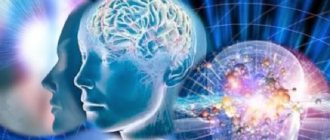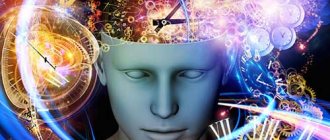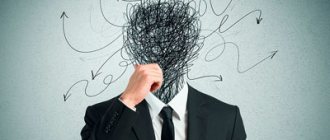Twilight disorder is a sudden and short-term loss of clarity of consciousness.
During this period, a person completely detaches himself from everything that surrounds him, or perceives the world distortedly. In the twilight state, habitual automatic actions are preserved, but delusions and hallucinations may appear, causing fear, melancholy, aggressive behavior, and rage. The attack passes as unexpectedly as it began. The individual has no memories of him, but sometimes they are fragmentary.
The twilight state of consciousness can last several minutes, days, and sometimes longer. It necessarily requires serious treatment by psychiatrists, since it poses a danger to both the person suffering from it and the people around him. Therefore, in the event of an attack, immediate hospitalization is necessary.
Causes and types
The causes of pathology are divided into two groups:
- organic - epilepsy, epileptiform syndrome, brain diseases, including tumors, damage to the medial temporal regions as a result of traumatic brain injury and a number of other conditions;
- functional - hysterical psychoses and narrowing of consciousness, affective states, unexpected situations with consequences in the form of severe psychological trauma.
There are twilight psychotic and non-psychotic disorders. The first include the following types, which have characteristic manifestations:
- Dysphoric twilight state of consciousness. A person acts in an orderly manner, he is self-absorbed, detached from the outside world, sad, does not respond to someone addressing him, or utters some stereotypical words that are not related to what the interlocutor is saying. The face is gloomy, even angry. Such patients can recognize familiar people and situations, but act inappropriately and are unable to critically evaluate what they are doing. Fleeting sensations of having a double, birth and death, etc. may arise.
- Delusional twilight disorder of consciousness. Delusional ideas are formed, and the patient’s behavior corresponds to their content. It seems to him that someone is pursuing him, wants to harm him, make him suffer, kill him. He is focused, behaves in an orderly manner, but normal communication with him is impossible. The patient’s actions are aimed at protecting against an imaginary threat dictated by delusion, most often antisocial. When the condition returns to normal, memories of the experience remain.
- Hallucinatory disorder is characterized by the presence of illusions and frightening visual and auditory hallucinations. Communication is impossible, since such a patient does not perceive reality and the appeal to him at all. He hums, pronounces or shouts individual words or phrases, most often inarticulate. As a reaction to terrible visions, aggression arises, the outbreaks of which result in very harsh actions performed with enormous force - beating, killing with bare hands or with the help of sharp objects.
A number of psychiatrists identify another type of psychotic twilight state of consciousness - oneiric. It is characterized by colorful fantastic or fairy-tale hallucinations, accompanied by catatonia - impaired motor functions, i.e. excitement or stupor.
Non-psychotic cloudings of consciousness include:
- Somniloquy - talking in your sleep.
- Somnambulism - sleepwalking, sleepwalking. Occurs in children and adolescents.
- Trances are long-term automatic actions. Most often, the patient leaves for another city.
- Outpatient automatisms are brief automatic actions. For example: a person leaves home, gets on public transport, and, upon waking up, finds himself incomprehensibly how and why in an unfamiliar place. The patient looks confused, thoughtful, there are no hallucinations or delusions. He does not remember at all what happened to him in a state of darkness.
- Genser's syndrome is a hysterical variant that occurs as a result of prolonged stress. The impetus for the development of the disorder is some kind of traumatic event, an unexpected exposure to unsafe, unusual conditions. The patient can only talk about these events, but he is not alienated from the world. The individual behaves like a clown, “falls into childhood” - he lisps, grimaces, and obviously answers simple questions absurdly. Knowing the purpose of things, he distorts their use, for example, he tries to pull gloves on his feet. Emotions suddenly change to the opposite. After an attack, the patient has fragmentary memories of what happened, which are restored after a good sleep.
The twilight state takes a person from reality to hallucinations. The latter replace a situation that was traumatic for him. Examples of darkness: amok - excitement, aggression and murder; the ritual of shamans - they introduce themselves into darkness and “infect” the participants in the action with it. An example can be given from literature - Lady Macbeth, the heroine of Shakespeare's tragedy of the same name, experiences a twilight episode in her sleep.
Why does consciousness disappear?
The main causes of disturbances of consciousness include:
- psychological disorders without visible structural changes in the brain;
- disorders of cerebral circulation and electrical activity of the brain;
- infectious, metabolic and mental diseases;
- drug addiction, alcoholism, substance abuse;
- concussions and traumatic brain injuries.
General symptoms
In a state of twilight disorder of consciousness, whatever type it may be, contact with the patient is impossible, since he is detached from the real world, does not perceive it partially or completely. His consciousness suddenly seems to turn off. He is disoriented to varying degrees in the situation, time, people, place. His thinking process is disrupted, his judgments are incoherent or completely absent.
It is difficult to distinguish a sick person from a healthy person by appearance, since he behaves quite normally and is capable of performing quite complex actions. However, as soon as you begin to communicate with him, it immediately becomes clear that the individual cannot say either his own name, the names of loved ones, or the date where exactly they are. Although his speech may be correct from a grammatical point of view, he cannot carry on a conversation, he talks to himself, does not answer questions and does not expect an answer to his own.
The behavior is usually aggressive and poses a danger to others.
After emerging from such a state, the patient remembers poorly or does not remember at all what happened to him and what he did.
Principles of therapy
Drug treatment is indicated. With a deep disorder of consciousness, contact with reality is lost, and not a single psychotherapist is able to “reach out” to the individual. Relief of acute symptoms is carried out in the hospital of the Leto clinic under round-the-clock medical supervision. If necessary, we will arrange transportation to the medical center.
The list of drugs used, their dosage, and duration of treatment depend on individual characteristics and the diagnosis. As a rule, sedatives and drugs for symptomatic therapy are used. After the patient’s condition improves, the patient is discharged, but the doctor must describe in detail the further treatment plan and talk about the need for consultations to correct the treatment plan.
Urgent Care
The danger of twilight disorder of consciousness is that the patient, under the influence of hallucinations, anxiety, and anger, can cause quite serious harm to himself and others, since extreme strength and aggression awakens in him. He can attack anyone nearby, destroy furniture, etc.
To avoid accidents and other negative consequences, you need to react to this condition very quickly. Of course, it is necessary to call an ambulance, but before the arrival of a specialized team, to ensure the safety of the patient, the patient should be persuaded to sit or lie down on the bed and not be left alone for a minute. It is necessary to ensure that there are no breakable or piercing objects, flammable or other dangerous substances nearby. You should not let him near windows, balconies, or doors.
For safe transportation of the patient, he is fixed and 2-4 ml of sibazon solution (0.5%) or Relanium, Seduxen, diazipam is administered intravenously. This is usually enough to calm him down. If the drug does not work, after 10 minutes you will have to administer half the dose of the same medicine. Neuroleptics with suprastin or diphenhydramine, as well as chlorpromazine, have a similar effect, but it lowers blood pressure, so it is not suitable for everyone.
A gloomy state can be a manifestation of epileptic seizures, then the gloom can be one-time or repeated. If a diagnosis of epilepsy is made and medications are prescribed, then the attack can be stopped with the prescribed medications. If psychomotor agitation does not go away, but increases, then mandatory hospitalization is required.
Clinical manifestations
The pathological disease leads to a complete disorder of consciousness. A person does not understand who he is, where he is and what he is doing.
The patient does not distinguish between his loved ones and those around him, and is not able to recognize the questions that are addressed to him. The period of amentia is accompanied by the following symptoms:
productive contact with the outside world is not possible; the patient cannot construct complete sentences or connect them in meaning; the victim pronounces meaningless individual words with multiple repetitions at varying volumes; the ability to synthesize is impaired, the patient is unable to connect events and objects with each other; due to deception of feelings, manifestations of delusional emotions and hallucinatory experiences, the patient is in a state of confusion, fearfulness, uncertainty, helplessness; the patient’s attention does not focus on one object for a long time; any new sound switches attention from one object to another; emotions are inadequate, randomly interspersed quickly; the patient can laugh and cry in one minute, be overly interested and indifferent to others; there are depressions that are not associated with external events; spending time in bed may be accompanied by active swings, rotations, shudders, bending of arms, legs and prolonged stupors; motor activity in bed may alternate with prolonged stupor; separate minute motor activity occurs; the patient may touch, grab, or push away objects without realizing their meaning.
After complete cure of the disease, the patient forgets the entire inadequate period of the disease. Due to refusal of food, prolonged amentia can lead to complete depletion of the body. In childhood, amentia syndrome is shallow and short-lived. A complete disorder of consciousness is not observed in children. The child is worried, constantly upset, distracted, and unable to navigate what is happening. Contact can be established, but not for a long time.
The child does not fully understand the meaning of addresses addressed to him, this leads to incorrect reactions to them.
Treatment
The diagnosis of “twilight disorder of consciousness” is made by a psychiatrist, studying the clinical picture and based on a conversation with the patient and his relatives. You will also need a consultation with a neurologist and a number of specialized specialists, as well as studies such as MRI and CT of the brain, EEG, etc.
If during the process of darkening the patient committed a crime: caused damage to property, harm to health or murder, then a forensic psychiatric examination is carried out. It, among other things, involves the study of documents compiled by law enforcement officers, forensic reports, and witness statements.
Treatment is carried out in the psychiatric department of the hospital with the help of antipsychotics and tranquilizers. The psychotic type of disorder will require individual psychotherapy. It is necessary in the event of a crime committed by a patient.
If the twilight state is of a non-psychotic type, then the underlying disease is treated.
Naturally, individual treatment tactics are selected for each patient, depending on the above factors.
Diagnostic methods
Given the variety of forms of the disease, each case requires an individual approach, and, unfortunately, doctors at the Leto mental health center sometimes cannot help. Thus, patients in a state of stupor, stupor and coma require emergency hospitalization. In such cases, all diagnostic and therapeutic measures are carried out in intensive care units.
Doctors at the Leto clinic diagnose qualitative disorders of consciousness. To determine the cause of the disease, an encephalogram is performed, a computed tomography scan of the brain is required, and, if necessary, a PET scan. We also ask for basic laboratory tests. Sometimes the patient is referred to related specialists.
Delirium
Delirious stupefaction is characterized by the presence of predominantly psychoproductive symptoms. These include abundant hallucinatory and illusory disorders and the acute sensory delirium determined by them. In this case, true visual hallucinations predominate, although tactile and auditory deceptions of perception are also possible. Their content is usually unpleasant for the patient and is threatening in nature. These can be monsters, beasts of prey, skeletons, small animals and insects, small humanoid creatures. Hallucinations quickly replace each other; wave-like influxes of visions are characteristic.
Behavior is subordinated to emotions, patients are usually restless motorly up to the development of psychomotor agitation. Aggression is directed at hallucinatory images and can affect others. Affect is variable and determined by the content of hallucinations. Generally, anxiety, anger, and fear predominate, but transient states of curiosity and enthusiasm are possible. Preoccupation with hallucinations leads to complete or partial disorientation, and false orientation in space and time is often noted.
Delirium is a wave-like condition. It is characterized by lucid windows: spontaneous periods of lucidity, when the patient’s perception of the environment and the overall level of brain functioning improve. The condition also worsens in the afternoon with an increase in hallucinatory influxes in the evening and at night. Lucid windows most often occur after awakening; during them, the person is asthenized, partially oriented and moderately critical. In addition, delirium is characterized by stages of development, with each stage being reversible.
At the first stage, there are no hallucinations yet, but there are influxes of vivid memories, increased and uncontrollable associations, and distracted attention. The person is talkative, affectively unstable, not critical enough and is not always clearly oriented. His behavior becomes inconsistent, and his sleep is restless and superficial, with disturbing, overly vivid dreams.
At the second stage, illusions and pareidolia appear, disturbances of attention are aggravated with difficulty in perceiving the environment. The third stage of delirium is characterized by multiple true hallucinations and associated sensory delusions. Even when scene-like visual hallucinations appear, the feeling of their alienness remains. The patient does not become involved in imaginary events, but observes them or opposes himself to them. Behavior is subject to emotions, orientation deteriorates sharply.
The fourth stage is a severe disintegration of thinking with complete immersion in experiences and detachment from the outside world. Delirium at this stage is called muttering. The man shakes something off himself, makes picking movements, fidgets with the bed, and mutters for a long time. Verbal activity is practically independent of external factors; strong sound and painful stimuli lead to a temporary increase in the volume of pronounced sounds and words.
A special form of delirious stupefaction is occupational delirium, in which hallucinatory-delusional disorders are fragmentary in nature and do not determine behavior. Against the background of deep detachment and disintegration of thinking, stereotypically repetitive movements appear, which are associated with the automation of the patient’s professional activity. This could be imitation of working on a machine, sweeping, using abacus, knitting. It is also possible to repeat simple gestures and body movements typical for a given person.
Oneiroid
The oneiric form of darkness is a disorder of human consciousness, manifested by a state of delirium and carrying the same symptoms: porridge in the head, sparkles in the eyes, fantastic visions and picturesque dreams that are far from reality. The state of the psyche is changeable, moving from detachment to hyperexcitation. The patient does not see or hear people nearby, he lives in his own fantasy world.
Such people are rarely highly active; they can sit or stand in the same place for hours without saying anything. The facial expression is stony, emotionless, sometimes frightening. After clearing their consciousness, such patients can talk about their travels and adventures, realistically perceiving their existence. Clarification of consciousness and a more realistic perception of reality comes to a person sometimes after a couple of weeks, but in some cases even after a couple of months.
conclusions
A patient with impaired consciousness needs urgent medical attention. Productive disorders of consciousness require immediate psychiatric care. Hospitalization and assistance are necessary, even forcibly, since such a patient may pose a danger to others or himself. Therefore, if your family, friends or loved ones exhibit characteristic signs of impaired consciousness, consult a doctor immediately.
We constantly detect plagiarism on our materials without providing a clickable follow link to them. In this case, without warning, we turn to Google DMCA , which leads to pessimization of the plagiarist. On the contrary, we welcome the popularization of our materials, but with the obligatory active follow link to this page psyhosoma.com/narushenie-soznaniya/ .









